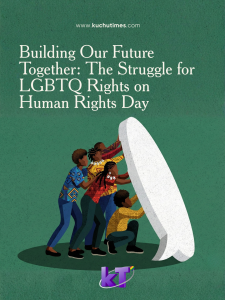As written by Masiiwa Ragies Gunda

Introduction
In the many discussions, debates and confrontations surrounding the LGBTI persons and Christians the world over, Sodom plays a critical role. In many communities, the public, popular and populist reactions have been whipped by invoking the danger of ending up like Sodom, that is, total extermination of a city and its people. Laws, especially emanating from the Victorian era in British history, were enacted to punish Sodom-like vice giving the State the moral justification to look at itself as acting on behalf of God. The underlying belief in all this contemporary usage of the image of Sodom is that Sodom was destroyed because of its sin. That sin is widely presented as “homosexuality”.
This brief article seeks to survey the understanding of the sin of Sodom in the Bible. The name Sodom, which occurs for the first time in Genesis 10:19, occurs 48 times throughout the Bible, the bulk of the usage is within the Old Testament and nine verses in the New Testament makes reference to Sodom. This piece seeks to establish how these texts understood or interpreted the Sodom narrative. Of especial importance is the post-Sodom destruction references to the name Sodom. The name Sodom occurs 27 times in the Old and New Testaments after the destruction of Sodom narrative in Genesis 18 and 19.
Summary of the Sodom Narrative
From Genesis 10, we are introduced to a place that is called Sodom. In Chapter 10 we are told that Sodom was outside the territory of Canaan but was adjacent to Canaan and possibly opposite direction to Gaza. This suggests that Sodom lay south east of Canaan since Gaza was south west of Canaan. In Genesis 13, in a clear retrospective reference, refers to the destruction of Sodom while characterizing the people of Sodom as “wicked and great sinners against the Lord” (vs.13). This is the region that Lot chose to settle in as they parted ways with Abraham. In Chapter 14, we are then told of a war that was waged by two coalitions of which one included a King Bera of Sodom. In these pre-destruction narratives, one could argue that Sodom was another normal kingdom, neighbouring Canaan in the ancient days.
From Genesis 18 through 19, we however encounter the narrative of the destruction of Sodom beginning with the arrival of three unidentified guests at Abraham’s Oak of Mamre place. Having shown great hospitality to the strangers, the Lord eventually self-identifies and then goes on to declare the mission that has brought them down this way, which is, to destroy Sodom because of its wickedness. Two of the guests proceed to Sodom and upon their arrival are welcomed by Lot who invites them to come into his house for the night before they can proceed on their journey. In the house of Lot, we are again informed of the great hospitality shown by the host towards total strangers. Later the same night, the “men of Sodom, both young and old” come to Lot’s house demanding that the visitors be released into their custody so “they can get to know them”.
Lot being aware of what it meant for the men to be “known” by the men of Sodom, pleaded on their behalf and even offered his two “virgin” daughters to the men as a way of appeasing them and possibly saving the dignity of his visitors. The visitors eventually react by striking them men of Sodom with blindness and then instructs Lot to take his family out of Sodom. Lot and his family escapes Sodom though unfortunately his wife “turned into a pillar of salt” having failed to obey the instructions from the strangers. In this narrative, it is clear that Sodom was destroyed because of the wickedness of the people who lived there. The question that comes to mind, is “what was the sin of Sodom?”
Sodom in the Old Testament
The first post-Genesis appearance of Sodom is in Deuteronomy 29:23 where the focus is not on the sin of Sodom but on the extend of the destruction that was visited on Sodom and her neighbouring cities. In this text, we are informed of the aftermath of the destruction, which left the area being uninhabitable to any form of life on land or water. In Deuteronomy 32:32, Sodom appears to be used metaphorically and sarcastically, as the source of all bad things or as the model of all those who are in opposition to the ways of God. Even though there are clear indications that the activities of the people of Sodom were evil and maybe even contagious, the actual deeds or deed are not mentioned explicitly. On the basis of these two texts, we are not in a position to answer our leading question: what was the sin of Sodom?
The name Sodom appears in the prophetic books that is where we now turn to. In Amos 4:11, there is reference to the overthrow of Sodom by God and is used as a warning to Israel to beware the fate of Sodom, which could also befall them. Amos, however, does not mention the sin of Sodom, which caused the Lord to overthrow it. In Zephaniah, Sodom is mentioned as well as a possible clue to the sin of Sodom.
“Therefore, as I live, says the LORD of hosts, the God of Israel, Moab shall become like Sodom and the Ammonites like Gomorrah, a land possessed by nettles and salt pits, and a waste forever. The remnant of my people shall plunder them, and the survivors of my nation shall possess them. This shall be their lot in return for their pride, because they scoffed and boasted against the people of the LORD of hosts” (Zep 2:9-10 NRS).
The prophet Zephaniah identifies “pride” as the sin of Sodom and sees the same as infecting the people of Moab and Ammon. In Isaiah 1:9 and 10, the name appears once in each verse. In verse 9, the name is invoked in such a way that it speaks about the extent of the destruction of Sodom. The implication in vs. 9 is that no survivor was left behind to propagate the lineage of Sodom. The destruction, therefore, was total extermination of a people. In vs. 10, the name is now being used metaphorically to refer to all rulers who preside over wickedness. Such rulers are now metaphorically associated with the “rulers of Sodom.”
While the texts implicitly accuse Sodom of sin and wickedness, the nature of the sin is not explicit. The same applies in Isaiah 3:9, the people of Judah are accused of being like the people of Sodom, who never tried to hide their sin or wickedness. They are accused of displaying their wickedness in public yet even here the wickedness is not explicitly mentioned. The last mention of Sodom by the prophet Isaiah is in Chapter 13:19, where the fate of Babylon is compared to the end of Sodom, that is, destruction.
In Jeremiah, we encounter yet another interpretation of the Sodom narrative beginning with Chapter 23:14, where again Sodom is used as a standard with which the fate of the inhabitants of Jerusalem could be compared. In this text, however, there are now some sins that are clearly identified and associated with the history of Sodom and still being practiced by the prophets of Jerusalem. “But in the prophets of Jerusalem I have seen a more shocking thing: they commit adultery and walk in lies; they strengthen the hands of evildoers, so that no one turns from wickedness; all of them have become like Sodom to me, and its inhabitants like Gomorrah” (Jer 23:14 NRS). While these are sins being observed among the prophets of Jerusalem, it appears from the use of Sodom that such sins were also associated with the people or men of Sodom.
In Jeremiah 49:8 and 50:40, there is again reference to the extent of the destruction, a total annihilation of the population of Sodom and the total extermination of the ability of the land to sustain life ever after! The same could be said of Lamentations 4:6, which also mentions the destruction of Sodom in the spur of the moment. There is no mention, however, of the sin of Sodom.
Outside of Genesis, the prophet Ezekiel is one of those who makes reference to Sodom many times. The name Sodom appears 6 times in Ezekiel 16 from verse 46 to 56. In vs. 46, even though Sodom and Samaria are personified, this verse helps in identifying the historical location of Sodom relative to Judah. Having identified the location and relationship of Sodom to Judah, they are sisters! In vs. 48, the text then alleges that a comparison of the deeds of Sodom and those of Judah, clearly shows that there are differences between the deeds.
The text argues, your sister Sodom and her daughters have not done what you and your daughters have done. At this stage, it is not clear whether Sodom did more or less when compared to Judah. In vs. 49-50, Ezekiel goes a step further by mentioning the sins of Sodom. “This was the guilt of your sister Sodom: she and her daughters had pride, excess of food, and prosperous ease, but did not aid the poor and needy. They were haughty, and did abominable things before me; therefore I removed them when I saw it” (Eze 16:49-50 NRS). Among the sins of Sodom were pride, having excess food while refusing to assist the poor and needy. They did not see hospitality as a virtue! In the following texts, there is the promise to restore Sodom and other punished states including Judah.
In the New Testament, the name Sodom appears for the first time in the narrative on the mission of the 12 disciples in Matthew 10 and Luke 10. In both texts, Sodom is used as an example for those towns and cities that would refuse to welcome the twelve. In both narratives, the disciples are instructed to wipe off the dust from inhospitable towns and cities thereby making such towns as candidates for destruction, which would be worse than that suffered by Sodom. It would appear that the sin of Sodom, according to the interpretation of the narrative by our Lord Jesus Christ, is that of inhospitality. In Matthew 11:23-24, Sodom is again used in a comparison between “then and now” with Capernaum being accused of being worse than Sodom since Capernaum had witnessed many miracles and other demonstrations of power, which were never availed to Sodom. In Luke 17:29, the focus is on the mode of destruction that visited Sodom, that is, the raining of sulphur and fire. The sin of Sodom is, however, not mentioned. From these Gospel passages, only the sin of inhospitality appears to be explicitly associated with the people of Sodom and that understanding is coming from our Lord Jesus Christ.
In Romans 9:29, the Apostle Paul makes reference to Isaiah’s use of the Sodom narrative and fate. In Romans, therefore, Paul acknowledges the believed extent of the destruction of Sodom, which is, that it was total and therefore left no survivor from among the men, women, and children of Sodom. The only difference with Judah or Israel was that the Lord had left some survivors for the later while no such survivor had made it for Sodom.
In 2 Peter 2:6, the Sodom narrative is once again used for its lessons to the present generations. While the focus is frequently on the destruction and wickedness of the people of Sodom, 2 Peter focuses on the act of God of saving Lot, the righteous man living among wicked people. While destruction is the sure fate of the wicked, it is also emphasized that even when ensconced by wicked people, the Lord will come to the rescue of the righteous. Coming the letter of Jude, we encounter the first association of the sin of Sodom directly with what is now being interpreted as “homosexuality”. “Likewise, Sodom and Gomorrah and the surrounding cities, which, in the same manner as they, indulged in sexual immorality and pursued unnatural lust, serve as an example by undergoing a punishment of eternal fire” (Jud 1:7 NRS). This is possibly the first time in the Bible that the threat to gang-rape the visitors is interpreted as the sin of Sodom from our survey. In Revelation 11:8, Sodom is used metaphorically or cryptically as it appears in an apocalyptic text but even then, there appears to be an association between the aftermath of the destruction of Sodom and what will befall some contemporary kingdoms fighting against the superpower of the time. There is clearly no mention of the sin of Sodom.
Summary: The Sins of Sodom
From the survey carried above, a handful of sins have been linked with the destruction of Sodom among them being pride, excess of food, refusal to assist the needy and poor, inhospitality to strangers, sexual immorality and same-sex lust. It would appear that the sin of inhospitality could have been the umbrella sin covering a host of manifestations of wickedness committed against vulnerable groups in Sodom including the strangers who happened to pass through Sodom. Most telling about the question of the sin of Sodom is the interpretation of the sin by none other than our Lord, Jesus Christ. His answer is that the people of Sodom were guilt of inhospitality! Only, when same-sex practices are driven by inhospitality can they be equated to the sin of Sodom.
May the Lord bless us in our quest to sustain life in our communities that we may never again proclaim destruction on people who have not committed any wickedness by simply accepting that the Lord has made them different! Difference is not inhospitality, however, forcing some to be like me when the Lord has made them different can end up being inhospitality! Are we not the ones in need of the fate of Sodom?




